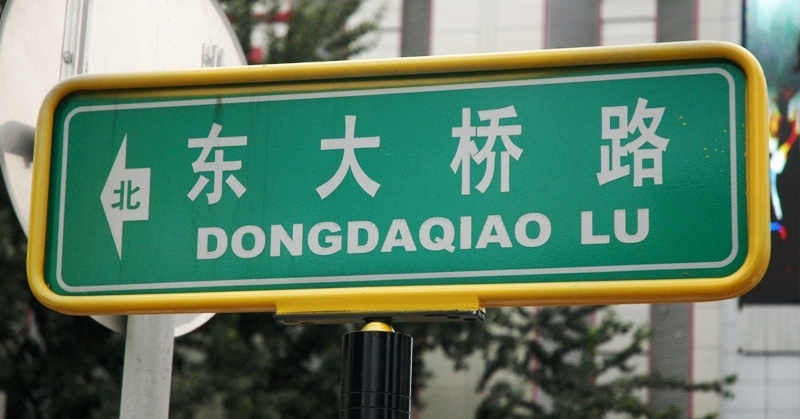Mandarin Monday: Navigating Beijing via the City's Color-Coded Road Signs
Despite Beijing being a comparatively easy city to navigate thanks to its grid formation, for the directionally or Mandarin-challenged, answering the seemingly simple question “Which way are you facing?” posed by Didi drivers can be the first hurdle in ever getting back home. Fear not though, as there's a simple trick that's not particularly well-known even among the seasoned Beijingers: the Beijing Traffic Management Bureau has handily color coordinated the city's street signs depending on which way you're facing.
Next time you're scratching your head in befuddlement, spot a white street sign and you'll know that you're positioned east-west, conversely green street signs point in a north-south direction. Best yet, it's not only Beijing that abides by these guidelines, most other cities across China utilize them too.
Additionally, hutong signs, which were originally white text on a red background but are slowly being standardized to a blue background with a white background, don't often indicate direction unless they're positioned at the mouth of the alley.

Also, if you are trying to locate a building on an unfamiliar road, you can follow these rules:
- East-west roads feature building numbers in order from east to west.
- North-south roads feature building numbers in order from north to south.
- North-facing buildings will have odd numbers, while south-facing buildings have even numbers.
- West-facing buildings have odd numbers, while east-facing buildings have even numbers.
So that you can match the unmatched bearings of even the most seasoned Beijing local, below we've compiled some useful Mandarin words and phrases to ensure you never get lost in the capital again.
Useful words
Taxi 出租车 chūzū chē
Taxi driver 师傅 shīfù
Traffic jam 交通堵塞 jiāotōng dǔsè
Please use the meter 请打表 qǐng dǎ biǎo
Where can I get a taxi? 哪里可以乘出租车。Nǎlǐ kěyǐ chéng chūzūchē.
Below are some useful phrases when using Didi Chuxing (滴滴 Dīdī), which also has an English version. (We recommend sitting in the back as a safety precaution and always ask for a receipt in case you leave something in the cab.)
The driver will usually call to ask you where you are and if your location is accurate.
Driver: I have arrived, where are you? 我到了,你在哪?Wǒ dàole, nǐ zài nǎ?
Passenger: I have arrived. 我到了。Wǒ dàole.
Passenger: I am at the location. 我就在定位。Wǒ jiù zài dìngwèi.
Passenger: I will be there in 1 min. 一分钟就到了。Yī fēnzhōng jiù dàole.
In the taxi
Where are you going? 你去哪?Nǐ qù nǎ?
I am going to ... 我要去。。。Wǒ yào qù ...
How much is it to ...? 到 ... 多少钱? Dào ... duōshǎo qián?
Which direction do you want to take? 你想怎么走?Nǐ xiǎng zěnme zǒu?
Follow the GPS route. 你跟着导航走吧。Nǐ gēnzhe dǎoháng zǒu ba.
Please wait here for a moment. 请在这里稍等一下。Qǐng zài zhèli shāo děng yíxià.
Turn left 左拐 zuǒ guǎi
Turn right 右拐 yòu guǎi
Go straight 直走 zhí zǒu
Make a U-turn 掉头 diàotóu
Slow down. 慢点开车 。Màn diǎn kāi chē.
Speed up. 快点开车。Kuài diǎn kāi chē.
Have we arrived? 我们到了吗?Wǒmen dàole ma?
How much longer will it take? 还要多长时间?Hái yào duō cháng shíjiān?
Do you mind turning the air conditioning on/off/up/down? 你介不介意把空调开/关/开得大一点/开得小一点?Nǐ jiè bù jiè yì bǎ kōngtiáo kāi/guān/kāi dé dà yī diǎn/kāi dé xiǎo yī diǎn?
I want to get out. 我想要下车。Wǒ xiǎng yào xià chē.
Stop the car/Please stop here. 停车/请停在这里。Tíngchē/Qǐng tíng zài zhèli.
Please give me the receipt. 请给我车费收据/小票。Qìng gěi wǒ chēfèi shōujù/xiǎo piào.
Payment
Driver: How will you pay? Cash/Wechat/Alipay? 你怎么支付?现金/微信/支付宝? Nǐ zěnme zhīfù? Xiànjīn/Wēixìn/Zhīfùbǎo
You scan me/I scan you. 你扫我/我扫你。Nǐ sǎo wǒ/wǒ sǎo nǐ.
READ: Mandarin Monday: Get Well Soon With These Over-the-Counter Chinese Medications
Images: Wikimedia, WeChat







